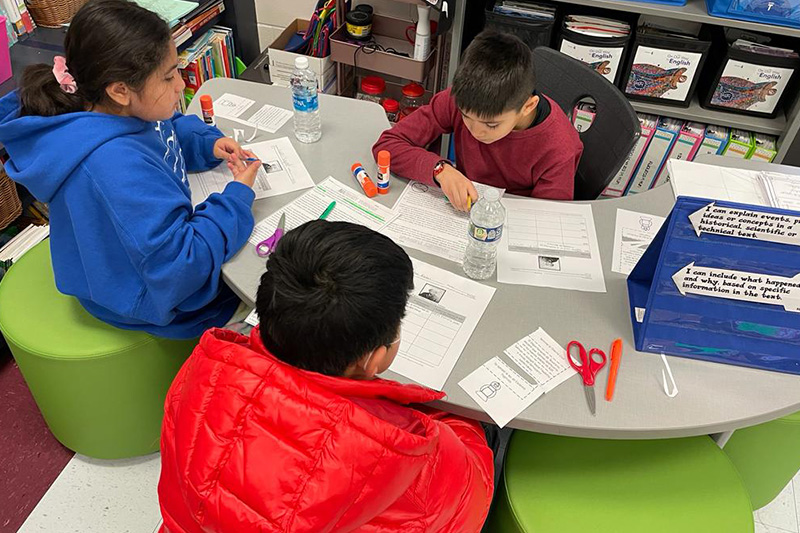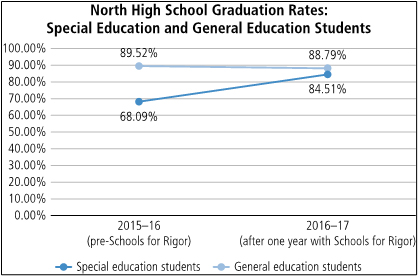
Pictured above: Students from School District U-46, where about 40% of students are English learners, are flourishing in their academic vocabulary as they engage in teams.
The Dilemma with Curriculum Resources for Special Populations
Most districts provide supplemental curriculum resources designed to meet the needs of students in special populations, such as English learners or those receiving special education services. However, there are often challenges associated with those resources:
- Misalignment with standards perpetuates lower proficiency: Specialized curriculum materials often do not align with the standards being taught during Tier 1 instruction. This misalignment results in a disconnect that can contribute to students in special populations falling farther and farther below grade level, particularly if they must miss Tier 1 instruction time to receive services.
- Quality varies widely and creates inconsistent results: The varying quality of curriculum resources for special populations can result in a totally different teaching and learning experience. In some cases, resources may include evidence-based comprehensive materials that address special needs without compromising the integrity of grade-level content. On the other hand, resources may consist of “choose your own adventure” lists of websites that teachers are expected to curate and assign.
Given these challenges, how can district leaders equip teachers to meet the diverse needs in their classrooms while ensuring all students have access to rigorous, engaging Tier 1 instruction?
A Model of Instruction for ALL Students
Those of us who have been in education for a decade or more have seen glimpses of what’s possible when students actively engage with peers while learning rather than passively listening and watching as the teacher gives information. Literature circles, cooperative learning, Socratic seminars, and other similar approaches that seemed so promising when first introduced have since become commonplace only for classes deemed gifted or well-behaved; students who can “handle” the challenge or have “earned” the right to talk to peers while learning. Where does that leave students who haven’t been placed in gifted programs or who find themselves in a classroom where self-regulation isn’t the norm?
Instructional Empowerment’s Model of Instruction for Deeper Learning™ provides the structures and tools for ALL students to engage in rigorous team tasks, leveraging the unique strengths of each student to lift the performance of the entire team. How?
- Diverse student teams: Students who are acquiring English work alongside students with disabilities, students who excel academically, and students who bring other special skills to the table. While interacting with their peers, students gain practice using both social and academic language in an authentic context.
- Structures designed for academic rigor and equal participation: With clearly defined roles and protocols, every student contributes to the success of the team as they tackle challenging problems with real-world applications. Every student is expected to participate and voice their thinking. The structures support students with low English proficiency who may otherwise be unable to communicate with their peers and teachers.
- Professional learning and resources for teachers to plan rich, interdependent tasks: Teachers plan tasks at the intent and rigor of the standards, using the curriculum resources. Teachers become skilled at determining which tasks are worthy of interdependent student teams, making adaptations as needed to curriculum resources and putting texts directly in the hands of students.
“A student who really ‘wowed’ me came into my classroom knowing no English at all. I put him in a group where I knew the facilitator was very strong, and I gave him the learning monitor role, because I knew I had lots of visuals up on the board that he could use to go through the directions. He has not only blossomed as a team member, but also in his English. The look on his face when he gets to be working in his team, it melts my heart. Seeing that he can be successful, a student who comes in knowing no English, he can do the work just like everybody else in the group – anybody can be successful in a team.”
Allison Berg
1st Grade Teacher, Des Moines Public Schools
Subscribe for curated education insights delivered every two weeks.
Meeting IEP Goals and WIDA ELD Standards
In addition to ensuring students are being taught grade-level standards, teachers working with special populations strive to support students’ progress towards IEP goals and WIDA English Language Development (ELD) standards. The Model of Instruction for Deeper Learning provides students with many more opportunities to engage in authentic conversations with peers than they would have through traditional classroom assignments, setting them up for success in reaching these goals and standards.
As students work interdependently with classmates and experience productive struggle, they develop a wide range of skills, including:
- Agency (the ability to self-direct their own learning)
- Executive functioning
- Self-regulation
- Communication
- Conflict resolution
While these skills are important for all students, they are even more critical for students learning English and students with disabilities who may not otherwise have opportunities to engage in this type of rigorous learning experience.

An example of success for students in special education comes from partner school North High, where student-led team learning helped raise graduation rates for students in special education by 16.42%, closing the gap with students in general education (see The Power of Student Teams, 2019, p. 96).
Despite the best intentions, teachers often underestimate what students in special populations can do. Student-led team learning through the Model of Instruction for Deeper Learning allows those students to shine and leverage strengths while growing in areas that are not yet fully developed.
About the Author
Meg Bowen
Meg Bowen, M. Ed., has spent more than thirty years in the field of education serving students, teachers, and administrators in North Carolina, Virginia, Maryland, and Florida. A graduate of the University of North Carolina Charlotte and James Madison University, Ms. Bowen completed doctoral coursework in curriculum at the University of Maryland.
Ms. Bowen has developed curriculum and supported its implementation in both elementary and secondary settings. After serving for several years as Assistant Principal and Principal, she became the Director of Elementary Curriculum for one of the nation’s largest school districts. Ms. Bowen now serves as the Executive Director of Customer Experience and Growth at Instructional Empowerment (IE), where she works diligently to ensure districts value partnering with IE so much that they continue to collaborate with us even after they achieve their initial goals. She encourages partner schools to reach and achieve model school status, where all students are engaged in rigorous learning activities and achieve their full potential.
Subscribe for curated education insights delivered every two weeks.
About Instructional Empowerment
Our mission is to end generational poverty and eliminate achievement gaps through redesigned rigorous Tier 1 Instruction that ensures deeper learning for ALL students.




